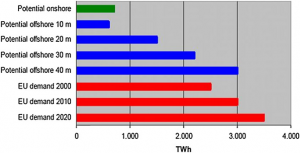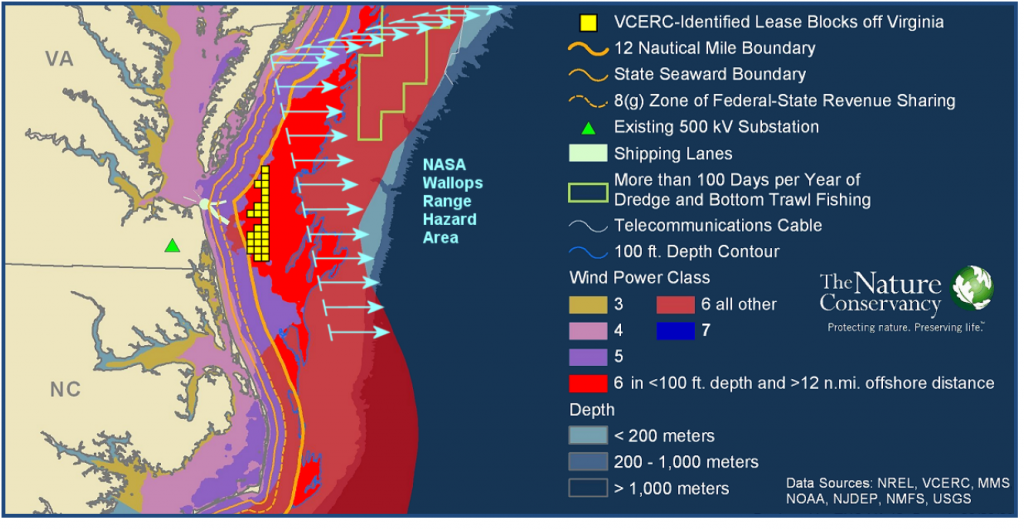Why wind energy? The simple answer is the growing need for renewable energy sources and the move away from burning fossil fuels. A better question would be: On shore or offshore wind turbines? According to figure 1, the potential for offshore energy far exceeds the potential for onshore energy and at some point it may even be possible to meet Europe’s energy demand in 2010 using 40 m offshore wind turbines.

Figure 1: The potential amount of energy in TWh, onshore and offshore at different depths, compared to energy demand in Europe. Source (2)
One of the reasons offshore turbines have a greater energy potential is the quality of wind offshore compared to on land. The farther from the coast, the stronger the winds are and in addition, offshore winds are less turbulent and more consistent, leading to less fatigue suffered by the turbine. One of the benefits of offshore turbines is their distance from the shore. Most people do not want to live near turbines due to turbines being an eye-sore, the noise they make, the shadow flickering they cause and the potential dangers of ice throw. (4)
There are however, several disadvantages to offshore wind energy. “While in onshore applications, the evaluation of wind resources in a specific site is straightforward and well established, direct measurements at sea are more difficult and much more expensive.” (1) 75% of the cost of an onshore turbine project is spent on the turbine itself, whereas only 33% of the project cost is spent on the turbine itself for an offshore project. (2) And although the turbine would be offshore away from land, there are still many who oppose it, “Some concerned citizens contend that offshore wind farms mar the natural beauty of the coastline, interfere with fishing, diminish property values, damage recreation and tourism, and harm marine wildlife and migratory birds” (3)
To get a better understanding of public opinion of the view of offshore wind turbines, Ian D. Bishop and David R. Miller conducted a survey analyzing the effects of wind turbines on the view of coastal waters. Respondents were shown 6 computer generated images of a number of wind turbines offshore at different depths and viewing conditions. Then were asked to rate each picture from 1-5, 1 being enhancing the view and 5 being detracting from the view, 3 being neutral.
“Average impact scores ranged from 3.08 to 4.11. The neutral position was 3 so in every case the turbines were judged to detract from the view. Overall about 11.6% of responses were positive. On the other hand, 51.1% of all responses were negative.” (5) The responses were clear, turbines offshore detracted from the beauty of the coastline.
This leads to another, less looked at option, island wind energy. The possibilities of Island wind energy are very broad; having the advantages of offshore wind energy without the disadvantages. The only disadvantage unique to this concept would be the difficulty in setting up underwater transmission of energy back to the continent. Not counting Hawaii and the Great Lakes, the US has roughly 1300 islands, almost half of them uninhabited. Although that is only 0.003 percent of the US’s land area, the 0.003 constitutes 10,612 square miles, which is plenty of land to establish island wind energy as a major source of the nation’s power. (3)
The many advantages of harnessing island wind energy include the total isolation of wind turbines from the population, meaning that no one could complain about them detracting from the beauty of the coastline, the turbines could not harm the marine wild life and the island would serve as a flat platform which would not require careful examination of the sea bed. The US could then use its extensive knowledge of onshore turbines to construct these island turbines.
The state with the best prospects for a successful implementation of island wind energy would be Virginia. “According to a recent survey, the state of Virginia possesses offshore wind potential 16 times greater than the amount of wind potential on land (as much as 32,000 MW offshore compared to 1960 MW onshore). The state boasts Class 6+ wind-energy resources located within 10–15 miles of the shoreline (Fig. 3).” (3)
Of more importance, specifically, are the Virginia barrier islands. These islands exist close to growing centers of electricity demand such as Richmond, Norfolk, and Washington, DC, making sure that there is always use for the energy and that it doesn’t have to travel far, making it easier to implement. (3)
A policy is defined as the planning, choices and actions of one or multiple authorities aimed at governing a certain societal development. (8) Luckily, Virginia already has some public policy support of wind energy, through the Virginia Energy Plan, which states that Virginia should ‘‘support federal efforts to examine the feasibility of off-shore wind energy being utilized in an environmentally responsible fashion.’ (3) Since 2010, there have been a number of onshore and offshore wind energy projects, but no specific mention of projects being started on the Virginia barrier islands. The Virginia barrier islands should not be overlooked and must be seriously considered when it comes to wind energy projects. The Virginia government should abandon onshore projects and push for new island wind energy projects in the barrier islands, perhaps through tax incentives. Section 6 of the Virginia Energy plan states that the Virginia Coastal Energy Research Consortium has completed two years of study on offshore wind energy. (7) The research consortium should stop studying offshore wind energy and start studying island wind energy so that projects in the Virginia Islands can begin sooner.
Works Cited.
1. D. Karamanis, C. Tsabaris, K. Stamoulis, D. Georgopoulos, Wind energy resources in the Ionian Sea, Renewable Energy, Volume 36, Issue 2, February 2011, Pages 815-822, ISSN 0960-1481, 10.1016/j.renene.2010.08.007.
(http://www.sciencedirect.com/science/article/pii/S0960148110003629)
2. M. Dolores Esteban, J. Javier Diez, Jose S. López, Vicente Negro, Why offshore wind energy?, Renewable Energy, Volume 36, Issue 2, February 2011, Pages 444-450, ISSN 0960-1481, 10.1016/j.renene.2010.07.009.
(http://www.sciencedirect.com/science/article/pii/S0960148110003332)
3. Benjamin K. Sovacool, Richard F. Hirsh, Island wind-hydrogen energy: A significant potential US resource, Renewable Energy, Volume 33, Issue 8, August 2008, Pages 1928-1935, ISSN 0960-1481, 10.1016/j.renene.2007.12.006.
(http://www.sciencedirect.com/science/article/pii/S0960148107003825)
4. Independent Expert Panel of Massachusetts Government. “Wind Turbine Health Impact Study” MassGov. January 2012.
http://www.mass.gov/dep/energy/wind/turbine_impact_study.pdf
5. Ian D. Bishop, David R. Miller, Visual assessment of off-shore wind turbines: The influence of distance, contrast, movement and social variables, Renewable Energy, Volume 32, Issue 5, April 2007, Pages 814-831, ISSN 0960-1481, 10.1016/j.renene.2006.03.009.
(http://www.sciencedirect.com/science/article/pii/S0960148106000838)
6. Figure 3: Map of the Virginia Barrier Islands on http://www.peregrinefalcon-bcaw.net/viewtopic.php?f=17&t=149
7. Governor Robert McDonnell. Section 6 of the 2010 Virginia Energy Plan
http://www.dmme.virginia.gov/DE/VAEnergyPlan/2010-VEP/Section6.pdf
8. Thijs Smit, Martin Junginger, Ruud Smits, Technological learning in offshore wind energy: Different roles of the government, Energy Policy, Volume 35, Issue 12, December 2007, Pages 6431-6444, ISSN 0301-4215, 10.1016/j.enpol.2007.08.011.
(http://www.sciencedirect.com/science/article/pii/S0301421507003667)



One Comment
msqmota posted on December 10, 2012 at 11:09 am
It is surprising that the offshore wind potential is 16 times greater than the amount of wind potential on land in the state of Virginia. I totally agree that the government should invest on wind energy projects in Virginia barrier islands, so the potential of wind turbines can be maximized.